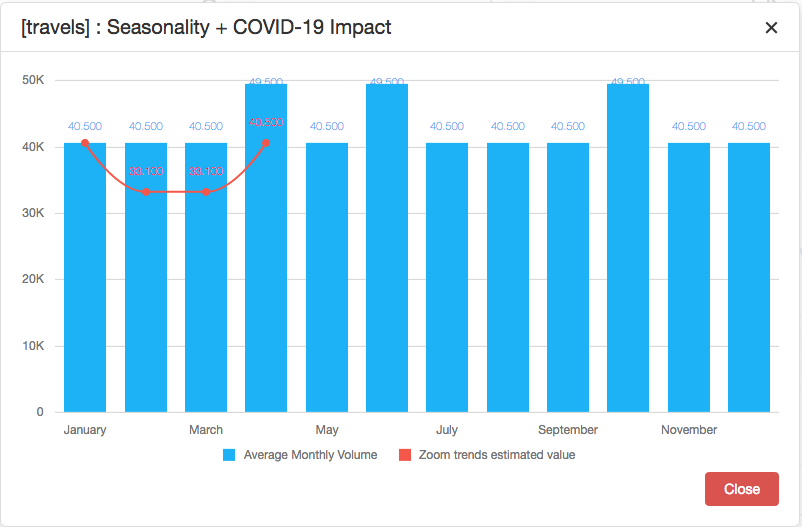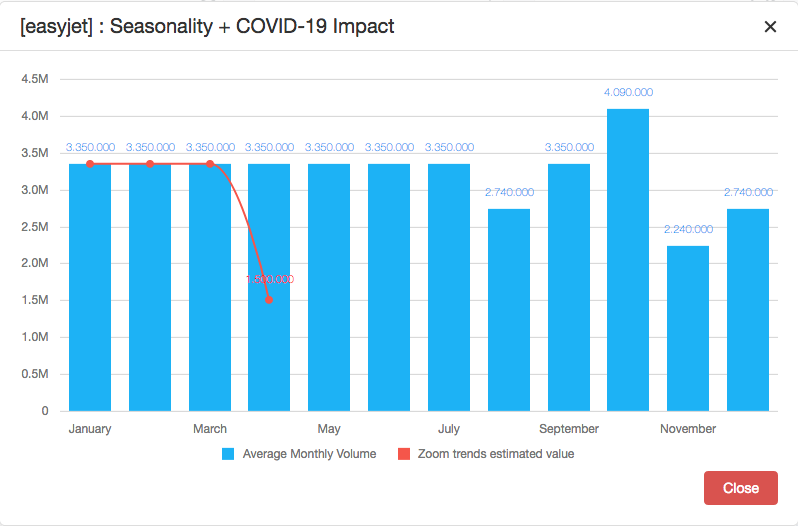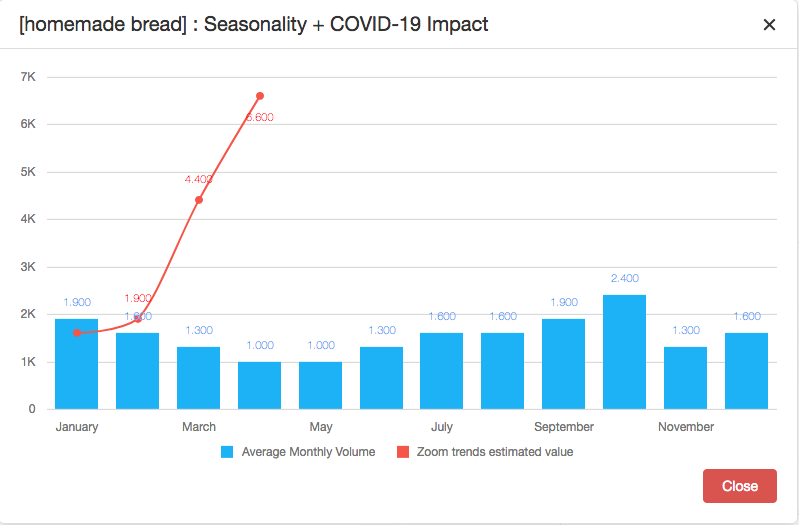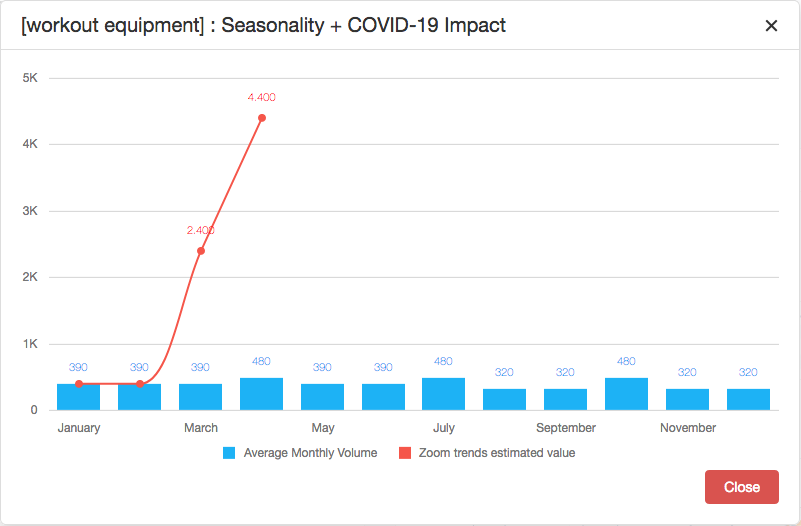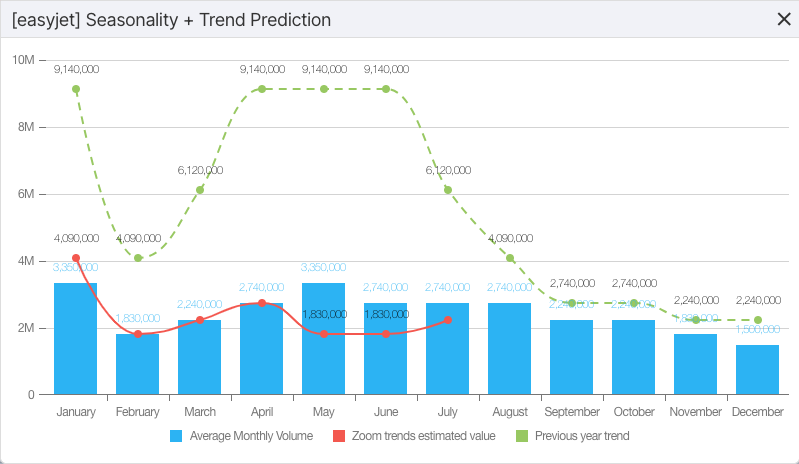Trend Prediction to read updated data on search volumes
It is a function that was born at a precise moment in history – its official debut took place on April 10, 2020, exactly one month after the first month of lockdown imposed as a countermeasure to the Coronavirus pandemic – and that responded to specific needs at that time, but revealed a necessary usefulness and practicality even later, when the situation finally normalized. We are talking about Forecast Trend, SEOZoom’s feature initially known as “Covid-19 impact,” precisely, which is based on an algorithm capable of providing accurate and rapid estimates of keyword search volumes, analyzing current trends in real time to offer up-to-date data.
Trend Prediction, the algorithm for measuring search volumes in real time
Unique of its kind among SEO tools, the Trend Prediction algorithm sits within the seasonality graph in keyword analysis and allows everyone to have clear information, but most importantly real data, to understand what is happening to searches in current events, and not on the canonical (and sometimes outdated) historical search volumes.
Technically speaking, the function uses search trends and reworks the estimate by projecting the interest shown in the previous 12 months onto today’s real scenario.
In practical terms, this makes it possible to visualize in every way, and practically in real time, what the forecast search volumes are for a keyword we are interested in, so as to make keyword analysis even more fruitful for strategic evaluations.
Clicking on the “show trend” button in the seasonality graph opens a more specific screen that shows three different pieces of information:
- Average monthly volume, consisting of a bar graph with volumes indicated by Google tools (i.e., the classic organic traffic estimate value that we display in all tools)
- Dashed green line, showing the trend from the previous year.
- Solid red line, showing the realistic search volume figure estimated by the Zoom Trends algorithm.
The red line, specifically, highlights the volumes detected by SEOZoom and actually predicted for this year, based on the surveyed data and trends; the green line, on the other hand, shows the trend detected last year: with our tool, SEOZoom shows in a projection executed on the basis of the base trend and surveyed data what is Google’s data crossed with what it actually saw in the organic SERPs as the months went by.
The Zoom Trend is thus an index that helps us understand how and (if) the average keyword volume has changed as a result of the latest updates. In this way, those working in digital at any level-from blogs to newspapers to professional consultants-can more easily and quickly understand search trends, compare data more accurately, and make appropriate considerations in a more strategic and informed way.
As we wrote at launch back in 2020, the idea behind the algorithm was to allow us to track the sudden and unforeseen evolution of online searches, in many areas completely disrupted by the looming Coronavirus and subsequent social and personal restrictions; in particular, at the time we asked “How have our priorities changed in this first month of lockdown? ” and “How much have people’s searches changed on Google because of all the measures to counter the Coronavirus,” trying to understand what then had been the effects on SERPs on search volumes for individual keywords and various industries, from tourism to DIY.
About a year later, in January 2021, our own Ivano Di Biasi announced the feature’s name change, motivated not only as “a superstitious gesture for the future” (at a time when Covid countermeasures were still frequent and stringent), but also as a necessity and a factual fact: the predictions provided by the tool, in fact, apply to any type of event that might ever occur in the real world, and not only to Covid.
The traffic estimates of SEO tools and the difference with SEOZoom
As mentioned, SEOZoom is the first SEO software to integrate such a feature, and all competing tools still rely on the “old” data retrieval system.
That is, until yesterday, in order to have reliable search volumes in any tool, it was necessary to wait for Google to collect its estimates and count the actual number of users who made certain searches in a month; when the annual statistics were ready, one could collect this information, relating precisely to the previous year. More precisely, the classic average volume is the one reported by Google that SEOZoom (as well as the other tools) updates periodically, but it clearly refers at least to the previous year, since Google “makes up” the value based on users’ searches.
So, and as is well known, all SEO tools so far offer only snapshots based on statistical averages relative to periods of normality. But then the Coronavirus came along, a sudden global emergency situation, and it disrupted all our life priorities, including search trends: many things that used to be fundamental to us have now become completely unnecessary, secondary, or impossible to do, such as movie outings, restaurant dinners, or travel.
In other words, the unpredictable impact of the Coronavirus on Google and searches totally invalidated the very meaning of SEO tools’ analysis procedures, because the traditional average based on the previous 12 months no longer had continuity in an absolutely different world scenario, and therefore search volumes for many keywords were no longer reliable and accurate.
We have always made a difference in SEOZoom by working on the quality of the data, and this is exactly what we have tried to do with the Forecast Trend function (formerly Covid-19 impact”), which is able to process data and keyword trends to assess what the current trend of search volume is for any keyword and sector, beyond any event that might affect people’s true behavior (as it was with the Coronavirus, precisely).
Useful feature for setting better strategies
Thanks to this feature, then, we can know what users’ needs are in advance, without waiting for the classic update of search volumes.
For those who manage websites or work in the digital sector, having immediate information about the extent of changing search habits on Google is crucial to stay competitive and intercept new needs new search intent of users in a timely manner, or to adjust their strategy towards keywords and topics of real current interest – and not on something that has had strong interest in the past, but is currently declining.
The impact of Coronavirus on Google searches, a few examples
Going back to that month of April 2020, we had conducted an initial and quick report – followed by a more in-depth study of the Covid-19 impact on Google – to show how important it was for the large number of sites and businesses that were taking heavy blows due to changes in searches (and people’s new needs) to try to react immediately, without waiting for more time or months for hard data with which to understand exactly what had changed.
These screens – dating precisely from 2020 and thus related to the old SEOZoom release – help us understand and quantify the variation in searches between regular periods and the current ones at that time.
The keyword travels, which generated 40.500 monthly researches on average, later dropped to 33.100.
The keyword easyjet, that used to generate 3.5 million monthly searches on average, then dropped to 1.5 (almost 60% less).
The keyword homemade bread used to have an average of 1.600 searches, but during the pandemic it skyrocketed to 673K monthly searches!
The keyword workout equipment went from an average volume of 390 to over 4.400K!
It was easy to understand the reason for such variations thinking about the current events we were experiencing – traveling was impossible and certainly not the first thought of people at home (and online tourism was in general one of the sectors that saw the biggest drops in terms of searches and visits to sites, in that first phase and in the following ones), while on the contrary, the need to discover methods of baking bread or keeping fit even at home was much more urgent, in respect to ordinances and security measures. It was, in short, a concrete demonstration of how and how much search intent influences Google.
A few years later and with a situation that we can call normalized and quieter (not to say “safe”), we can see with the new realase and with the new tool how much the trends have changed with these new screens:
Today, in 2023, the kw “travels” has an average volume of 40,500 monthly searches, but SEOZoom’s in-depth analysis reveals that the actual figures are slightly different and very much related to seasonality: for example, last April the volume spiked to 60,500 searches and, while for this year the estimated zoom trends showed a similar monthly value, currently (July 2023) the figure has heavily dropped to an average of 27,100 monthly searches.
Also on the rise we have the keyword “Easyjet”, which has returned to 7-digit figures: the historical historical spike last year, March/June, that saw the average over 9 million searches, has then led to a recalibration of the zoom trends to the 1.830 million figure.
A tool to get updated data in real time
Back to the present, then, as you can easily guess if user interest in any topic/industry decreases, it will consequently happen that the search volume for all keywords in that particular industry will drop dramatically, while for emerging industries the exact opposite will happen.
With SEOZoom and the Trend Forecasting feature, for the first time, we can have real and accurate data on the effects of these trends and new search volumes, which can be used to devise effective strategies to counteract or consolidate them, to always be sure to work on trending keywords right now.



